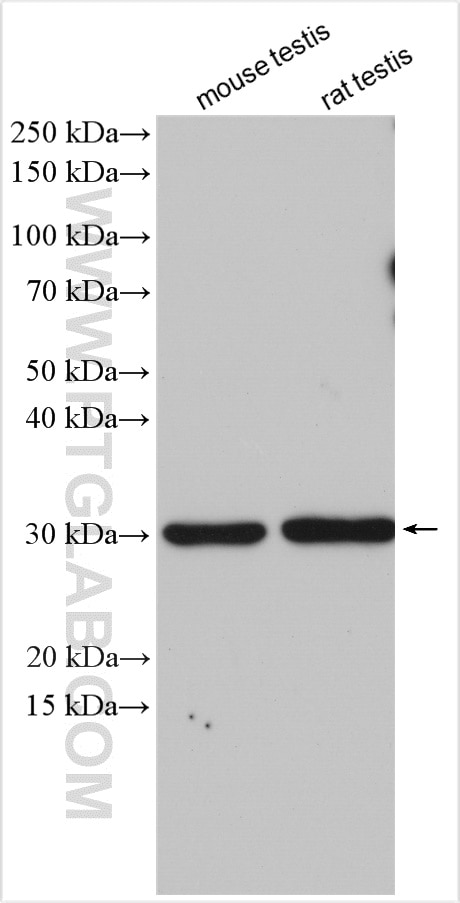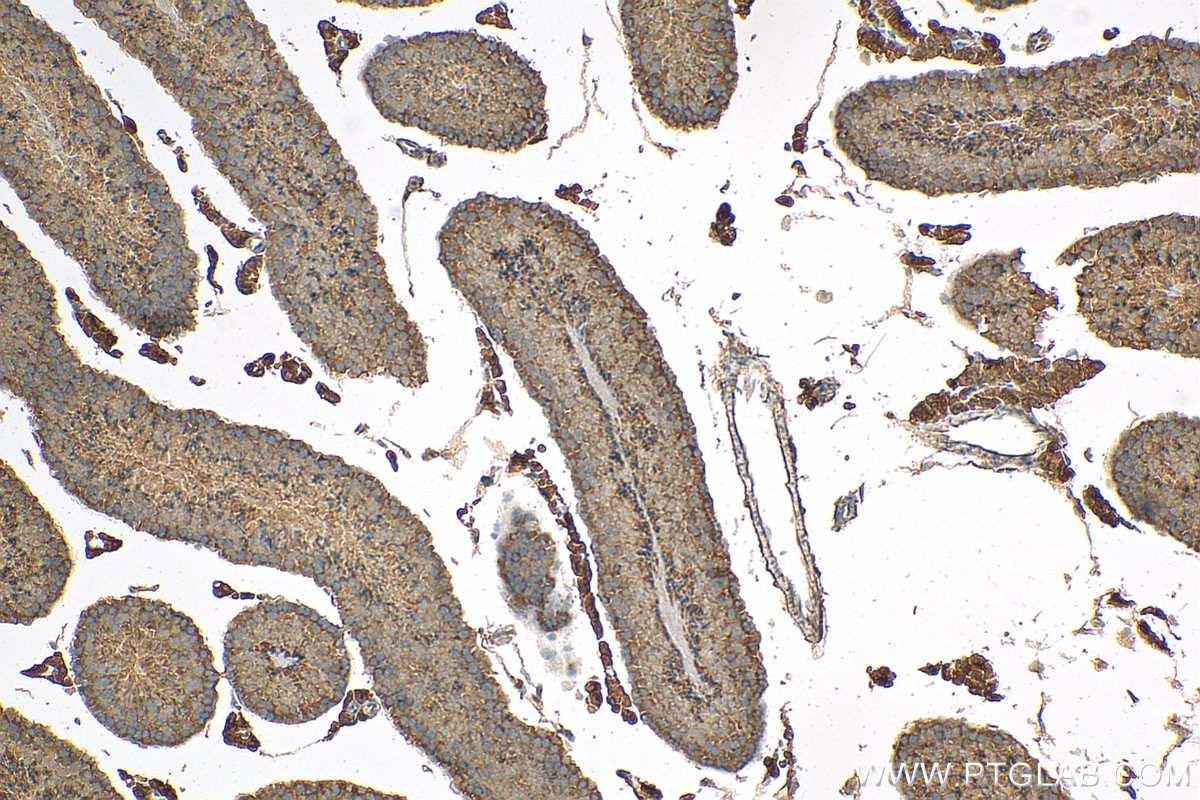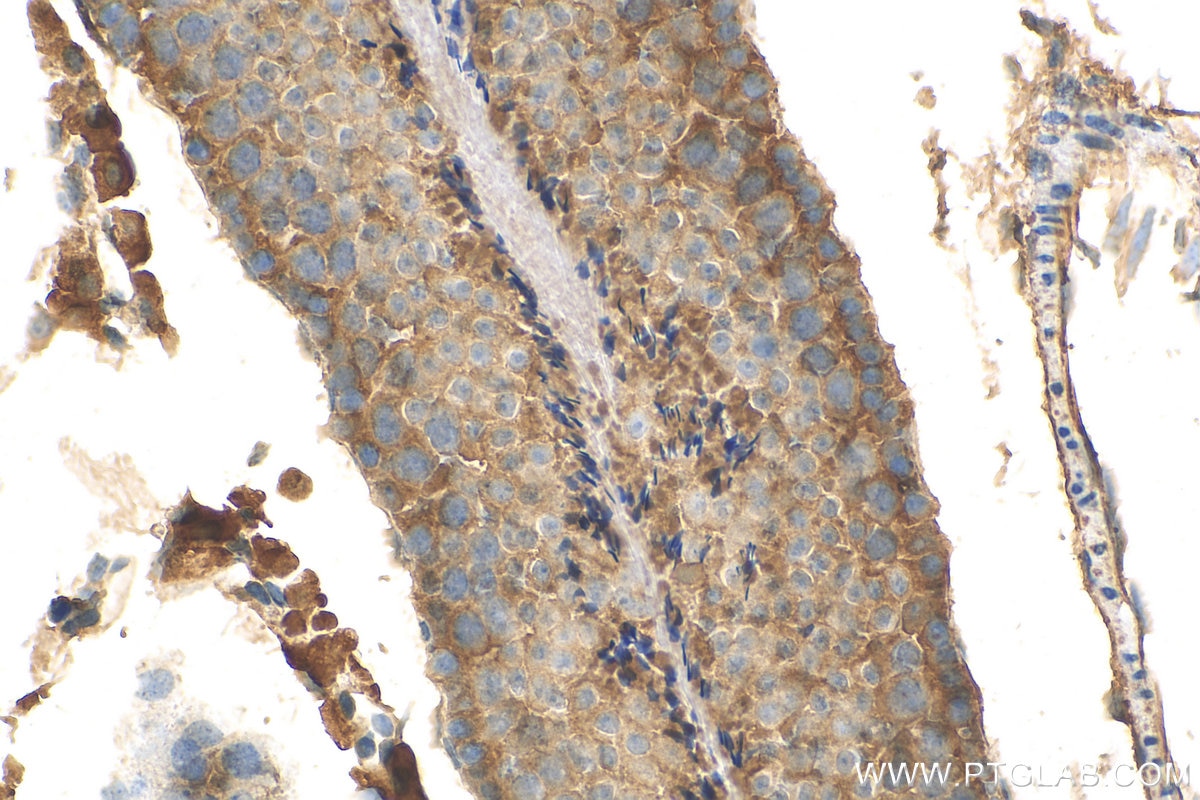LY96/MD2 Polyklonaler Antikörper
LY96/MD2 Polyklonal Antikörper für WB, IHC, ELISA
Wirt / Isotyp
Kaninchen / IgG
Getestete Reaktivität
human, Maus, Ratte
Anwendung
WB, IHC, IF, IP, CoIP, ELISA
Konjugation
Unkonjugiert
Kat-Nr. : 11784-1-AP
Synonyme
Galerie der Validierungsdaten
Geprüfte Anwendungen
| Erfolgreiche Detektion in WB | Maushodengewebe, Rattenhodengewebe |
| Erfolgreiche Detektion in IHC | Maushodengewebe Hinweis: Antigendemaskierung mit TE-Puffer pH 9,0 empfohlen. (*) Wahlweise kann die Antigendemaskierung auch mit Citratpuffer pH 6,0 erfolgen. |
Empfohlene Verdünnung
| Anwendung | Verdünnung |
|---|---|
| Western Blot (WB) | WB : 1:500-1:2000 |
| Immunhistochemie (IHC) | IHC : 1:50-1:500 |
| It is recommended that this reagent should be titrated in each testing system to obtain optimal results. | |
| Sample-dependent, check data in validation data gallery | |
Veröffentlichte Anwendungen
| WB | See 7 publications below |
| IHC | See 1 publications below |
| IF | See 2 publications below |
| IP | See 1 publications below |
| CoIP | See 1 publications below |
Produktinformation
11784-1-AP bindet in WB, IHC, IF, IP, CoIP, ELISA LY96/MD2 und zeigt Reaktivität mit human, Maus, Ratten
| Getestete Reaktivität | human, Maus, Ratte |
| In Publikationen genannte Reaktivität | human, Maus, Ratte |
| Wirt / Isotyp | Kaninchen / IgG |
| Klonalität | Polyklonal |
| Typ | Antikörper |
| Immunogen | LY96/MD2 fusion protein Ag2447 |
| Vollständiger Name | lymphocyte antigen 96 |
| Berechnetes Molekulargewicht | 160 aa, 18 kDa |
| Beobachtetes Molekulargewicht | 20-26 kDa |
| GenBank-Zugangsnummer | BC020690 |
| Gene symbol | MD2 |
| Gene ID (NCBI) | 23643 |
| Konjugation | Unkonjugiert |
| Form | Liquid |
| Reinigungsmethode | Antigen-Affinitätsreinigung |
| Lagerungspuffer | PBS mit 0.02% Natriumazid und 50% Glycerin pH 7.3. |
| Lagerungsbedingungen | Bei -20°C lagern. Nach dem Versand ein Jahr lang stabil Aliquotieren ist bei -20oC Lagerung nicht notwendig. 20ul Größen enthalten 0,1% BSA. |
Hintergrundinformationen
LY96, also named as ESOP1 or MD 2, is a small secreted glycoprotein that can bind to both the hydrophobic portion of LPS and to the extracellular domain of TLR4. The interaction between MD-2 and LPS bridges the two TLR4 molecules and induces the dimerization of LPS-MD-2-TLR4, which forms the structural basis for biological functions of TLR4/MD-2 complex. Due to its essential role in mediating the interaction between LPS and TLR4, MD-2 has been extensively explored as a therapeutic target for treatment of inflammatory disorders.
Protokolle
| Produktspezifische Protokolle | |
|---|---|
| WB protocol for LY96/MD2 antibody 11784-1-AP | Protokoll herunterladen |
| IHC protocol for LY96/MD2 antibody 11784-1-AP | Protokoll herunterladen |
| Standard-Protokolle | |
|---|---|
| Klicken Sie hier, um unsere Standardprotokolle anzuzeigen |
Publikationen
| Species | Application | Title |
|---|---|---|
Front Oncol MD2 Is a Potential Biomarker Associated with Immune Cell Infiltration in Gliomas. | ||
J Cardiovasc Transl Res Macrophage CD36 and TLR4 Cooperation Promotes Foam Cell Formation and VSMC Migration and Proliferation Under Circadian Oscillations. | ||
Molecules Sal B Alleviates Myocardial Ischemic Injury by Inhibiting TLR4 and the Priming Phase of NLRP3 Inflammasome. | ||
Oncol Rep Curcumin inhibits cell proliferation and migration in NSCLC through a synergistic effect on the TLR4/MyD88 and EGFR pathways. | ||
J Agric Food Chem Biotransformation of 18β-Glycyrrhetinic Acid by Human Intestinal Fungus Aspergillus niger RG13B1 and the Potential Anti-Inflammatory Mechanism of Its Metabolites | ||
Bioorg Chem The antimicrobial peptide LK2(6)A(L) exhibits anti-inflammatory activity by binding to the myeloid differentiation 2 domain and protects against LPS-induced acute lung injury in mice |




